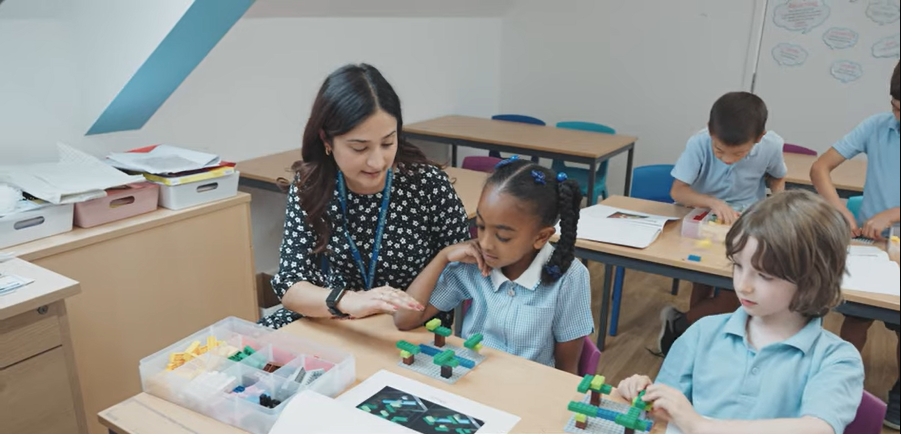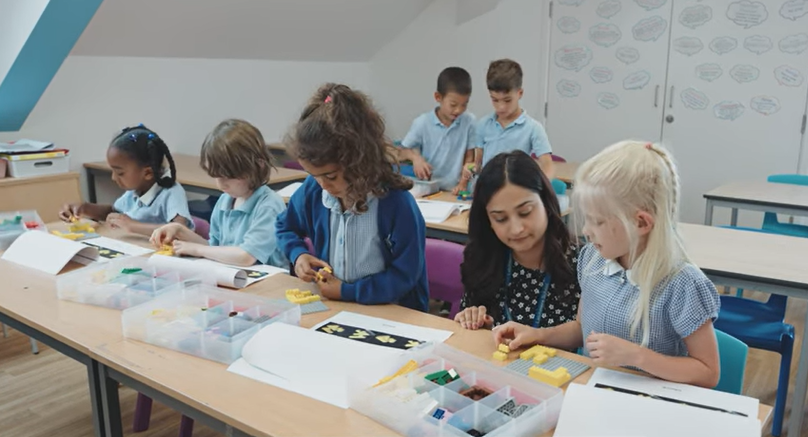

The pool of STEM skills needed to drive economic success in future decades is being shaped right now.

By young children ...
... playing with LEGO and jumping around adventure playgrounds.

Chances are, you’re using spatial reasoning every day. From getting dressed, loading the dishwasher to reading a map, many activities in daily life require the ability to understand the size and location of objects, and to visualise these problems in the mind.
But did you know that these abilities can be developed from birth and play a significant role in childhood mathematics attainment, problem-solving and lifelong Science, Technology, Engineering and Mathematics (STEM) skills?

Despite research evidence showing that spatial reasoning activities in early years and primary school improve interest and attainment in maths, there is currently little provision for mandating spatial learning in the early years or school curriculum.
Professor Emily Farran, Professor of Cognitive Development in the University of Surrey’s School of Psychology, has been making the case for more integrated approaches.
“Spatial reasoning, involves understanding the position, dimensions and properties of objects and their relation to one another. A large body of research shows that children with good spatial reasoning skills are also better at maths. The good news is that spatial reasoning can be easily trained from a young age, and this can improve both spatial ability and maths attainment. It also has potential to reinvigorate the way we teach all sorts of subjects.”

Working with the Early Childhood Maths Group, Professor Farran has developed a Spatial Reasoning Toolkit providing spatial activities and associated resources for use in the classroom by practitioners and schoolteachers working with children from birth to age seven.
“Our toolkit provides a clear overview for practitioners, informed by research evidence, with accessible and engaging activities for children of different ages and backgrounds in early years ” explains Professor Farran.
In its first year, it reached over 265,000 education practitioners.

So what do these activities look like for children?
From babies starting to move and explore their environment ...

... to toddlers showing awareness of different shapes when playing with blocks ...

... and then on to school age children using number lines and other hands-on tools to count - there are a mix of simple activities that support spatial training.
The Toolkit includes recommendations of age-appropriate activities. These can be simple, low-resource and enjoyable ways to use spatial activities in a nursery, classroom or home setting.
It also goes further than just mathematics, to adapting routine teaching methods in other subjects, for example by using spatial language and gestures in lessons, or providing puzzles and blocks for indoor play.
Breaking barriers to opportunity


Importantly, the impact of regular opportunities for children to think and work spatially goes beyond enhancing individual improvement in mathematics and science abilities, and could play a key role in the government’s core mission to ‘break barriers to opportunity’.
Children from disadvantaged backgrounds typically have lower spatial skills, lower spatial language and reduced access to spatial toys; therefore these children have the biggest room for growth in spatial thinking.
Inclusion of spatial reasoning in the curriculum has potential to decrease attainment gaps, which have been widened by the impact of the COVID-19 pandemic, to create more confident children who have a deeper understanding and appreciation of mathematics.
Given that spatial reasoning in childhood predicts adult expertise in Science, Technology, Engineering and Mathematics (STEM), there is also exciting long-term potential to address the current STEM skills shortage in the UK, which amounts to more than £1.5bn in losses annually.
Creating a resilient and productive STEM workforce of the future, inclusive of more individuals from more communities, has never been more important given the current employment revolution and increasing prevalence of data and technology roles.

The Royal Society recommends system reform
This is supported by the Royal Society who launched their ‘Mathematical Futures Report in September 2024, making the case for a new approach to mathematical and data education to equip future citizens with the skills they need to thrive.
This report supports the call for a stronger focus on spatial reasoning in the early years and primary curriculum, citing Professor Farran’s work. She also co-authored a preceding report, specifically looking at Spatial Reasoning, with the Royal Society Advisory Committee on Mathematics Education .

Time for change

The Spatial Reasoning Toolkit is already having real-world impact by shaping learning in schools.
It has been adopted for inclusion in the early years and primary teacher training pathways by Teach First, a teacher-training organisation in England and is part of the spatial reasoning pathway of the Government’s National Centre for Excellence in the Teaching of Mathematics (NCETM) for primary school teachers.
It is also listed as further reading in the Department for Education online child development training module.
However, in order to see systemic change and deliver the biggest benefits to children, more needs to be done.

Professor Farran is passionate about engaging directly with important stakeholders and policymakers in the UK and beyond to make this change happen.
Earlier this year she met with then Chief Secretary to the Treasury Laura Trott (pictured third from right), during a visit to the Bright Horizons Nursery on Surrey's campus.
Bright Horizons are an international childcare provider operating over 1000 nurseries worldwide, and during the visit Professor Farran briefed Ros Marshall, their UK MD, and the Chief Secretary on the impact of spatial reasoning in the early years curriculum.
Further afield, a team in the Netherlands plan to translate the Spatial Reasoning Toolkit into Dutch and she has twice presented to a working group commissioned by the French government to improve mathematics teaching in France.
Her commitment to policy changes also led to a meeting with then Shadow Education Secretary Bridget Phillipson, with colleagues in the Early Childhood Maths Group, highlighting the need for a spatialised curriculum.


“It has been fascinating to learn about the routes for engagement and share our work in these exciting conversations with diverse stakeholders. Translating Surrey research so it shapes the real world is always our goal. This work is already delivering impact, to the benefit of today’s children. Helping early-years teachers today to inspire the potential STEM leaders of tomorrow. Hearing the positive feedback from teachers using spatial training has been very rewarding – but there’s so much more that can be done through the work we are doing with policymakers, sector bodies and industry partners to embed this across the UK, and beyond."
This mission continues as Professor Farran engages with the Department for Education Curriculum and Assessment Review, which seeks to refresh the curriculum from Key Stage 1 upwards, to ensure it is cutting edge, fit for purpose and meeting the needs of children and young people to support their future life and work.
She has submitted evidence to this, highlighting that the mathematics curriculum is out of date, and must include more explicit reference to spatial reasoning through all phases, with better support for teachers and practitioners.
Following attendance at one of the regional roadshow events for the Review, she said:
"The London Curriculum and Assessment Review regional roadshow in London in November was a really useful event. It was great to have the opportunity to discuss curriculum and assessment with such a mix of teachers, charities, policymakers and researchers, with engaging Q&A.
The key working principle for me is that this review will be rigorously evidence and data informed, which is essential for reshaping education to future-proof the next generation.”

Policy Recommendations

1. The mathematics curriculum should include more explicit reference to spatial reasoning, with associated assessment. This should include visualisation for problem-solving, spatial representation of numbers, data and relationships, and the use of spatial language and gesture.
2. The geometry curriculum in particular should be expanded to include spatial skills, such as visualisation, perspective taking and spatial scale.
3. Spatial training in classrooms should use physical items, such as building blocks, pattern blocks or outdoor obstacles, which enable the most effective training and maths gains.
4. The majority of practitioners and teachers are not confident in their definition of spatial reasoning. Therefore, they should be provided with appropriate professional development to enable them to confidently support the curriculum and assessment change, for example including in the Early Career Framework.
Research at Surrey will continue to shape the future of education and is committed to boosting STEM success.
If you want to find out more:
Similar Stories
Surrey Shapes a clean air future for all
Discover how Professor Prashant Kumar's research is identifying solutions to minimise the harmful effects of air pollution.





